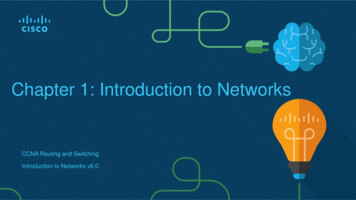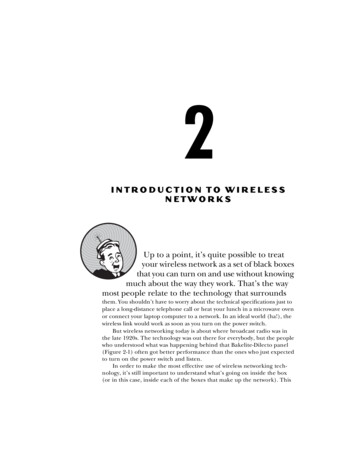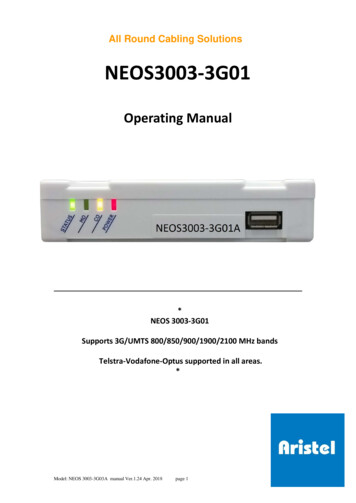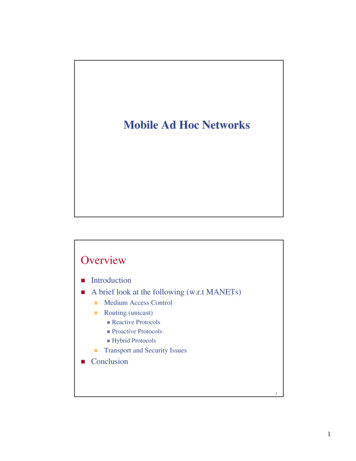
Transcription
Chapter 1: Introduction to NetworksCCNA Routing and SwitchingIntroduction to Networks v6.0
Chapter 1 - Sections & Objectives 1.1 Globally Connected Explain how multiple networks are usedin every day life. Explain how networks affect the way weinteract, learn, work and play.Explain how host devices can be used asclients, servers, or both. 1.3 The Network as a Platform Explain the basic characteristics of anetwork that supports communication in asmall to medium-sized business. Explain the concept of a converged network. Describe the four basic requirements of a reliablenetwork. 1.2 LANs, WANs, and the Internet Explain how topologies and devices areconnected in a small to medium-sizedbusiness network. Explain the use of network devices. Compare the devices and topologies of a LANto the devices and topologies of a WAN. Describe the basic structure of the Internet. Explain how LANs and WANs interconnect tothe Internet. 2016 Cisco and/or its affiliates. All rights reserved. Cisco Confidential2
Chapter 1 - Sections & Objectives (Cont.) 1.4 The Changing Network Environment Explain trends in networking that willaffect the use of networks in small tomedium-sized businesses. Explain how trends such as BYOD, onlinecollaboration, video, and cloud computing arechanging the way we interact. Explain how networking technologies arechanging the home environment. Identify some basic security threats andsolutions for both small and large networks. Explain why it is important to understand theswitching and routing infrastructure of anetwork. 2016 Cisco and/or its affiliates. All rights reserved. Cisco Confidential3
1.1 Globally Connected 2016 Cisco and/or its affiliates. All rights reserved. Cisco Confidential4
Networking TodayNetworks in Our Daily Lives Welcome to a world where we are more powerful together, than we ever could be apart. Welcome to the human network. 2016 Cisco and/or its affiliates. All rights reserved. Cisco Confidential5
Networking TodayTechnology Then and Now We live in a world we barely imagined 20 years ago. What wouldn’t we have without the Internet? What will be possible in the future using the network as the platform? 2016 Cisco and/or its affiliates. All rights reserved. Cisco Confidential6
Networking TodayNo Boundaries Advancements in networking technologies are helping create a world without boundaries. The immediate nature of communications over the Internet encourages global communities. Cisco refers to the impact of the Internet and networks on people the “human network”. 2016 Cisco and/or its affiliates. All rights reserved. Cisco Confidential7
Networking TodayNetworks Support the Way We Learn Do you remember sitting in a classroom, like this? You don't have to be in school anymore to take a class. You don't have to be in a classroom to havea teacher. 2016 Cisco and/or its affiliates. All rights reserved. Cisco Confidential8
Networking TodayNetworks Support the Way We Work The globalization of the Internethas empowered individuals tocreate information that can beaccessed globally. Forms of communication: Texting Social Media Collaboration Tools Blogs Wikis Podcasting 2016 Cisco and/or its affiliates. All rights reserved. Cisco Confidential9
Networking TodayNetworks Support the Way We Work Data networks have evolved intohelping support the way we work. Online learning opportunities decreasecostly and time consuming travel. Employee training is becoming morecost effective. 2016 Cisco and/or its affiliates. All rights reserved. Cisco Confidential10
Networking TodayNetworks Support the Way We Play We listen to music, watch movies,read books, and download materialfor future offline access. Networks allow online gaming inways that were not possible 20years ago. Offline activities have also beenenhanced by networks includingglobal communities for a widerange of hobbies and interests. How do you play on the Internet? 2016 Cisco and/or its affiliates. All rights reserved. Cisco Confidential11
Providing Resources in a NetworkNetworks of Many Sizes Small Home Networks – connect a fewcomputers to each other and the Internet Small Office/Home Office – enablescomputer within a home or remote officeto connect to a corporate network Medium to Large Networks – manylocations with hundreds or thousands ofinterconnected computers World Wide Networks – connectshundreds of millions of computers worldwide – such as the Internet 2016 Cisco and/or its affiliates. All rights reserved. Cisco Confidential12
Providing Resources in a NetworkClients and Servers Every computer connected to anetwork is called a host or end device. Servers are computers that provideinformation to end devices on the network.For example, email servers, web servers, orfile server Clients are computers that send requests tothe servers to retrieve information such as aweb page from a web server or email froman email server. 2016 Cisco and/or its affiliates. All rights reserved. Cisco Confidential13
Providing Resources in a NetworkPeer-to-Peer Client and server software usually run on separate computers. However, in small businesses or homes, it is typical for a client to also function as the server.These networks are called peer-to-peer networks. Peer-to-peer networking advantages: easy to set up, less complex, and lower cost. Disadvantages: no centralized administration, not as secure, not scalable, and slowerperformance. 2016 Cisco and/or its affiliates. All rights reserved. Cisco Confidential14
1.2 LANs, WANs, and the Internet 2016 Cisco and/or its affiliates. All rights reserved. Cisco Confidential15
Network ComponentsOverview of Network Components A network can be as simple as a singlecable connecting two computers or ascomplex as a collection of networks thatspan the globe. Network infrastructure contains three broadcategories of network components: Devices Media Services 2016 Cisco and/or its affiliates. All rights reserved. Cisco Confidential16
LANs, WANs, and the InternetNetwork Components End Devices An end device is where amessage originates from orwhere it is received. Data originates with an enddevice, flows through thenetwork, and arrives at anend device 2016 Cisco and/or its affiliates. All rights reserved. Cisco Confidential17
Network ComponentsIntermediary Network Devices An intermediary device interconnects end devices in a network. Examples include:switches, wireless access points, routers, and firewalls. The management of data as it flows through a network is also the role of anintermediary device including: Regenerate and retransmit data signals. Maintain information about what pathways exist through the network and internetwork. Notify other devices of errors and communication failures. 2016 Cisco and/or its affiliates. All rights reserved. Cisco Confidential18
Network ComponentsNetwork Media Communication across a network iscarried through a medium whichallows a message to travel fromsource to destination. Networks typically use three types ofmedia: Metallic wires within cables, such ascopper Glass, such as fiber optic cables Wireless transmission 2016 Cisco and/or its affiliates. All rights reserved. Cisco Confidential19
Network ComponentsNetwork Representations Network diagrams, often called topologydiagrams, use symbols to representdevices within the network. In addition to the device representationson the right, it is important to rememberand understand the following terms: Network Interface Card (NIC) Physical Port Interface 2016 Cisco and/or its affiliates. All rights reserved. Cisco Confidential20
Network ComponentsTopology Diagrams Note the key differences between the two topology diagrams (physical location of devices vs.ports and network addressing schemes) 2016 Cisco and/or its affiliates. All rights reserved. Cisco Confidential21
LANs and WANsTypes of Networks Two most common types of networks: Local Area Network (LAN) – spans asmall geographic area owned oroperated by an individual or ITdepartment. Wide Area Network (WAN) – spans alarge geographic area typicallyinvolving a telecommunications serviceprovider. Other types of networks: Metropolitan Area Network (MAN) Wireless LAN (WLAN) Storage Area Network (SAN) 2016 Cisco and/or its affiliates. All rights reserved. Cisco Confidential22
LANs and WANsLocal Area Networks Three characteristics of LANs: Spans a small geographic areasuch as a home, school, officebuilding, or campus. Usually administered by asingle organization or individual. Provides high speed bandwidthto end and intermediary deviceswithin the network. 2016 Cisco and/or its affiliates. All rights reserved. Cisco Confidential23
LANs and WANsWide Area Networks Three characteristics of WANs: WANs interconnect LANs over wide geographical areas such as between cities, states, or countries. Usually administered by multiple service providers. WANs typically provide slower speed links between LANs. 2016 Cisco and/or its affiliates. All rights reserved. Cisco Confidential24
The Internet, Intranets, and ExtranetsThe Internet The Internet is a worldwide collectionof interconnected LANs and WANs. LANs are connected to each otherusing WANs. WANs are then connected to eachother using copper wires, fiber opticcables, and wireless transmissions. The Internet is not owned by anyindividual or group, however, thefollowing groups were developed tohelp maintain structure: IETF ICANN IAB 2016 Cisco and/or its affiliates. All rights reserved. Cisco Confidential25
The Internet, Intranets, and ExtranetsIntranets and Extranets Unlike the Internet, an intranet is aprivate collection of LANs and WANsinternal to an organization that is meantto be accessible only to theorganizations members or others withauthorization. An organization might use an extranetto provide secure access to theirnetwork for individuals who work for adifferent organization that need accessto their data on their network. 2016 Cisco and/or its affiliates. All rights reserved. Cisco Confidential26
Internet ConnectionsInternet Access Technologies There are many ways to connect usersand organizations to the Internet: Popular services for home users andsmall offices include broadband cable,broadband digital subscriber line (DSL),wireless WANs, and mobile services. Organizations need faster connectionsto support IP phones, videoconferencing and data center storage. Business-class interconnections areusually provided by service providers(SP) and may include: business DSL,leased lines, and Metro Ethernet. 2016 Cisco and/or its affiliates. All rights reserved. Cisco Confidential27
Internet ConnectionsHome and Small Office Internet Connections Cable – high bandwidth, always on,Internet connection offered by cabletelevision service providers. DSL – high bandwidth, always on,Internet connection that runs over atelephone line. Cellular – uses a cell phone networkto connect to the Internet; onlyavailable where you can get a cellularsignal. Satellite – major benefit to rural areaswithout Internet Service Providers. Dial-up telephone – an inexpensive,low bandwidth option using a modem. 2016 Cisco and/or its affiliates. All rights reserved. Cisco Confidential28
Internet ConnectionsBusinesses Internet Connections Corporate business connections mayrequire higher bandwidth, dedicatedconnections, or managed services.Typical connection options forbusinesses: Dedicated Leased Line – reservedcircuits within the service provider’snetwork that connect distant offices withprivate voice and/or data networking. Ethernet WAN – extends LAN accesstechnology into the WAN. DSL – Business DSL is available invarious formats including SymmetricDigital Subscriber Lines (SDSL). Satellite – can provide a connectionwhen a wired solution is not available. 2016 Cisco and/or its affiliates. All rights reserved. Cisco Confidential29
1.3 The Network as a Platform 2016 Cisco and/or its affiliates. All rights reserved. Cisco Confidential30
Converged NetworksTraditional Separate Networks An example of multiple networksmight be a school 30 years ago.Some classrooms were cabledfor data networks. Those sameclassrooms were cabled fortelephone networks, and alsocabled separately for video. Each of these networks useddifferent technologies to carry thecommunication signals using adifferent set of rules andstandards. 2016 Cisco and/or its affiliates. All rights reserved. Cisco Confidential31
Converged NetworksThe Converging Network Converged data networks carrymultiple services on one linkincluding data, voice, and video. Unlike dedicated networks,converged networks can deliverdata, voice, and video betweendifferent types of devices over thesame network infrastructure. The network infrastructure uses thesame set of rules and standards. 2016 Cisco and/or its affiliates. All rights reserved. Cisco Confidential32
Reliable NetworkNetwork Architecture Network Architecture refers to thetechnologies that support the infrastructurethat moves data across the network. There are four basic characteristics that theunderlying architectures need to address tomeet user expectations: Fault Tolerance Scalability Quality of Service (QoS) Security 2016 Cisco and/or its affiliates. All rights reserved. Cisco Confidential33
Reliable NetworkFault Tolerance A fault tolerant network limits theimpact of a failure by limiting thenumber of affected devices. Multiple paths are required for faulttolerance. Reliable networks provideredundancy by implementing apacket switched network. Packetswitching splits traffic into packetsthat are routed over a network. Eachpacket could theoretically take adifferent path to the destination. This is not possible with circuit-switched networks which establishdedicated circuits. 2016 Cisco and/or its affiliates. All rights reserved. Cisco Confidential34
Reliable NetworkScalability A scalable network can expandquickly and easily to support newusers and applications withoutimpacting the performance ofservices to existing users. Network designers follow acceptedstandards and protocols in order tomake the networks scalable. 2016 Cisco and/or its affiliates. All rights reserved. Cisco Confidential35
Reliable NetworkQuality of Service Voice and live video transmissionsrequire higher expectations forthose services being delivered. Have you ever watched a live videowith constant breaks and pauses?This is caused when there is ahigher demand for bandwidth thanavailable – and QoS isn’tconfigured. Quality of Service (QoS) is theprimary mechanism used to ensurereliable delivery of content for allusers. With a QoS policy in place, therouter can more easily manage theflow of data and voice traffic. 2016 Cisco and/or its affiliates. All rights reserved. Cisco Confidential36
Reliable NetworkSecurity There are two main types of networksecurity that must be addressed: Network infrastructure security Physical security of network devices Preventing unauthorized access to themanagement software on those devices Information Security Protection of the information or datatransmitted over the network Three goals of network security: Confidentiality – only intendedrecipients can read the data Integrity – assurance that the datahas not be altered with duringtransmission Availability – assurance of timelyand reliable access to data forauthorized users 2016 Cisco and/or its affiliates. All rights reserved. Cisco Confidential37
1.4 The Changing NetworkEnvironment 2016 Cisco and/or its affiliates. All rights reserved. Cisco Confidential38
Network TrendsNew Trends The role of the network must adjustand continually transform in order tobe able to keep up with newtechnologies and end user devicesas they constantly come to themarket. Several new networking trends thateffect organizations and consumers: Bring Your Own Device (BYOD) Online collaboration Video communications Cloud computing 2016 Cisco and/or its affiliates. All rights reserved. Cisco Confidential39
Network TrendsBring Your Own Device Bring Your Own Device (BYOD) is amajor global trend that allows usersto use their own devices giving themmore opportunities and greaterflexibility. BYOD allows end users to have thefreedom to use personal tools toaccess information andcommunicate using their: Laptops Netbooks Tablets Smartphones E-readers 2016 Cisco and/or its affiliates. All rights reserved. Cisco Confidential40
Network TrendsOnline Collaboration Individuals want to collaborate andwork with others over the networkon joint projects. Collaboration tools including CiscoWebEx (shown in the figure) givesusers a way to instantly connect,interact and achieve theirobjectives. Collaboration is a very high priorityfor businesses and in education. 2016 Cisco and/or its affiliates. All rights reserved. Cisco Confidential41
Network TrendsVideo Communication Cisco TelePresence powers the new way of working where everyone, everywhere, can be moreproductive through face to face collaboration. Around the world each day, we transform organizations by transforming our customerexperiences. 2016 Cisco and/or its affiliates. All rights reserved. Cisco Confidential42
Network TrendsCloud Computing Cloud computing is a global trend thatallows us to store personal files or backupour data on servers over the Internet. Applications such as word processing andphoto editing can also be accessed usingthe Cloud. Cloud computing also allows businesses toextend their capabilities on demand anddelivered automatically to any deviceanywhere in the world. Cloud computing is made possible by datacenters. Smaller companies that can’tafford their own data centers, lease serverand storage services from larger datacenter organizations in the Cloud. 2016 Cisco and/or its affiliates. All rights reserved. Cisco Confidential43
Network TrendsCloud Computing (Cont.) Four types of Clouds: Public Clouds Services and applications are made available tothe general public through a pay-per-use model orfor free. Private Clouds Applications and services are intended for aspecific organization or entity such as thegovernment. Hybrid Clouds Made up of two or more Cloud types – forexample, part custom and part public. Each partremains a distinctive object but both are connectedusing the same architecture. Custom Clouds 2016 Cisco and/or its affiliates. All rights reserved. Cisco Confidential44
Network TrendsTechnology Trends in the Home Smart home technology is a growingtrend that allows technology to beintegrated into every-day applianceswhich allows them to interconnect withother devices. Ovens might know what time to cook ameal for you by communicating withyour calendar on what time you arescheduled to be home. 2016 Cisco and/or its affiliates. All rights reserved. Cisco Confidential45
Network TrendsPowerline Networking Powerline networking can allowdevices to connect to a LAN wheredata network cables or wirelesscommunications are not a viableoption. Using a standard powerline adapter,devices can connect to the LANwherever there is an electrical outlet bysending data on certain frequencies. 2016 Cisco and/or its affiliates. All rights reserved. Cisco Confidential46
Network TrendsWireless Broadband In addition to DSL and cable, wirelessis another option used to connecthomes and small businesses to theInternet. More commonly found in ruralenvironments, a Wireless InternetService Provider (WISP) is an ISP thatconnects subscribers to designatedaccess points or hotspots. Wireless broadband is anothersolution for the home and smallbusinesses. Uses the same cellular technology used bya smart phone. An antenna is installed outside the houseproviding wireless or wired connectivity fordevices in the home. 2016 Cisco and/or its affiliates. All rights reserved. Cisco Confidential47
Network SecuritySecurity Threats Network security is an integral part ofnetworking regardless of the size ofthe network. The network security that isimplemented must take into accountthe environment while securing thedata, but still allowing for quality ofservice that is expected of thenetwork. Securing a network involves manyprotocols, technologies, devices, tools,and techniques in order to secure dataand mitigate threats. Threat vectors might be external orinternal. 2016 Cisco and/or its affiliates. All rights reserved. Cisco Confidential48
Network SecuritySecurity Threats (Cont.) External threats: Viruses, worms, and Trojan horses Spyware and adware Zero-day attacks, also called zero-hourattacks Hacker attacks Denial of Service attacks Data interception and theft Identify Theft Internal threats: Whether intentional or not, many studiesshow that the internal users of the networkcause the most security breaches. With BYOD strategies, corporate data ismore vulnerable. 2016 Cisco and/or its affiliates. All rights reserved. Cisco Confidential49
Network SecuritySecurity Solutions Security must be implemented in multiplelayers using more than one securitysolution. Network security components for home orsmall office network: Antivirus and antispyware software should beinstalled on end devices. Firewall filtering used to block unauthorizedaccess to the network. 2016 Cisco and/or its affiliates. All rights reserved. Cisco Confidential50
Network SecuritySecurity Solutions (Cont.) Larger networks have additionalsecurity requirements: Dedicated firewall system to providemore advanced firewall capabilities. Access control lists (ACL) – used tofurther filter access and traffic forwarding. Intrusion prevention systems (IPS) –used to identify fast-spreading threatssuch as zero-day attacks. Virtual private networks (VPN) – used toprovide secure access for remoteworkers. 2016 Cisco and/or its affiliates. All rights reserved. Cisco Confidential51
Network ArchitectureCisco Network Architecture In order for networks to function whileefficiently supporting connections ofpeople, devices, and information in amedia rich converged environment,the network must be built upon astandard network architecture. Network architecture refers to thedevices, connections, and productsthat are integrated to support thenecessary technologies andapplications. The foundation of all networkarchitectures including the Internet arerouters and switches. 2016 Cisco and/or its affiliates. All rights reserved. Cisco Confidential52
Network ArchitectureCCENT and CCNA Certification Cisco Certified Network Associate (CCNA) Routing and Switching Certification Requires you to pass two exams: First exam: Cisco Certified Entry NetworkTechnician (CCENT) Second exam focuses on IPv4 and IPv6routing and WAN technologies as well as LANswitching and infrastructureservices/maintenance 2016 Cisco and/or its affiliates. All rights reserved. Cisco Confidential53
1.5 Chapter Summary 2016 Cisco and/or its affiliates. All rights reserved. Cisco Confidential54
ConclusionWarriors of the Net The animated video below will help you visualize networking concepts. http://www.warriorsofthe.net/ 2016 Cisco and/or its affiliates. All rights reserved. Cisco Confidential55
ConclusionExploring the Network Networks and the Internet havedramatic impact on our lives. A network can consist of two devices,or can be as large as the Internet,consisting of millions of devices. The network infrastructure is theplatform that supports the network. Networks must be: Fault tolerant Scalable Support Quality of Service Secure 2016 Cisco and/or its affiliates. All rights reserved. Cisco Confidential56
ConclusionChapter 1: Introduction to Networks Explain how multiple networks are used in every day life. Explain how topologies and devices are connected in a small to medium-sized business network. Explain the basic characteristics of a network that support communication in a small to medium-sized business. Explain trends in networking that will affect the use of networks in small to medium-sizedbusinesses. 2016 Cisco and/or its affiliates. All rights reserved. Cisco Confidential57
Local Area Network (LAN) – spans a small geographic area owned or operated by an individual or IT department. Wide Area Network (WAN) – spans a large geographic area typically involving a telecommunications service provider. Other types of networks: Metropolitan











